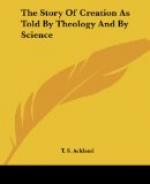During the interval between the deposition of the coal measures, which seem to belong to the third, and the Saurian remains which mark the fifth day, we have the Permian and Triassic Rocks, of which the Magnesian. Limestone and the new Red Sandstone are the most important representatives in England. Till a very recent period it was thought that these rocks belonged to a period remarkably destitute of animal life, very few fossils having been found in them. Recently, however, some very rich deposits have been found in the Tyrol, belonging to this period, but they are only local.
Of the Permian formation Sir C. Lyell says, “Not one of the species (of fossils) is common to rocks newer than the Palaeozoic.” [Footnote: Geology for Students, p. 369.] This was not then a time for the origination of new forms of life. In the Trias, however, the new development of life, which was to attain its full dimensions on the fifth day, begins to open upon us. The earliest Saurian fossils are found, and the rocks still present us with impressions of the feet of reptiles and birds, which walked over the soft seashore, and left footprints, which were first dried and hardened by the sun and wind, and then filled up with fresh sand by the returning tide, but never entirely coalesced with the new material.
At the close of this period the first traces of mammalian life occur, in the shape of teeth, which are supposed to have belonged to some small Marsupial quadrupeds, and in America the whole lower jaws of three such animals have been discovered; but no other remains have as yet been traced.
The Trias then seems to mark the boundary between the fourth and fifth days. The fourth day seems to have been on the earth a period of great change, not only in physical conditions, but also in the forms of life. In the latter point of view, however, it seems to have been marked by the passing-away of old forms much more than by the origination of new ones, and hence the barrenness of the Geological Records is in exact accordance with the silence of the Mosaic Record as to any new developments.
SECTION 8. THE FIFTH DAY
“And God said. Let the waters swarm swarms, the soul of life, and let fowl fly above the earth in the face of the firmament of heaven.
“And God created the monsters, the great ones, and every soul of life that creepeth, with which the waters swarmed, after their kind, and every winged fowl after his kind; and God saw that it was good.
“And God blessed them, saying, Be fruitful and multiply, and fill the waters in the sea, and let fowl multiply on the earth.
“And there was evening, and there was morning, a fifth day.”
The fifth and sixth days of Creation are those to which the theory of development chiefly refers. It will, therefore, be better to defer the consideration of its bearing on the narrative till the relation of that narrative to Geological facts has been considered, since it can only be thoroughly weighed when taken in connexion with the facts which belong to the two days.




